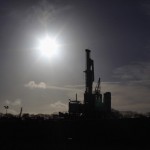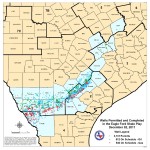More Pipelines in Texas for a Smelly, Deadly Gas

Dave Fehling / StateImpact Texas
Oil field workers wear these safety alert devices that detect hydrogen sulfide gas
Hydrogen sulfide — a gas that smells like rotten eggs — can be insidious in its lethality. Its odor will be unmistakeable to its victim. But the gas can quickly numb the sense of smell, leading to the belief that the threat has passed. Unconsciousness and death can follow.
“Unfortunately, if you come in contact with hydrogen sulfide there are not a lot of second chances,” said Sheldon McKee, director of business development at AMGAS, a Canadian company that makes equipment to remove hydrogen sulfide in the oilfields, where it can be a deadly risk for workers.
AMGAS opened an office last year in San Antonio to serve what the company sees as a growing need. Drilling for oil has surged just south of San Antonio in a swath of rural counties that comprise the Eagle Ford Shale. It’s an area known for what’s called “sour gas:” natural gas and crude oil with high amounts of hydrogen sulfide. Sour gas can also be found in parts of West Texas and in East Texas.
“The one thing that’s really changing in Texas is, a lot of the oil is being moved by truck and rail. Now you have introduced a release point of the hydrogen sulfide. So it’s just kind of how the boom has happened,” McKee told StateImpact Texas.
According to federal statistics, hydrogen sulfide has killed 10 workers in Texas in the past decade. They included drivers of tanker trucks hauling hazardous waste, as well as a worker in a gas processing plant.
Pipelines for the Deadly Gas
Another measure of the increased need to handle hydrogen sulfide gas is the number of applications for pipeline permits coming before the Railroad Commission of Texas. The permits are sought by oil and gas well operators who need to move sour gas from well sites to processing plants. Those facilities remove the hydrogen sulfide, making the gas “sweet” and therefore acceptable to be sent to pipelines that feed the natural gas market.
In 2009, the Railroad Commission approved four such applications. In 2011, the number shot up to 18. The commission has now approved a total of 42 hydrogen sulfide pipelines in the past five years. There have been no applications denied.
That was the case last month, when commissioners approved an 11-mile hydrogen sulfide gas pipeline that will run past 25 homes and 15 public roads near the town of Levelland, just west of Lubbock. According to testimony from the commission’s staff, those homes and roads are within the “radius of exposure” should the gas leak.
The staff estimated that in a radius under one mile there would be potential exposure of 100 to 500 parts per million (ppm) of the gas. Federal guidelines say such exposures could mean a loss of smell and lung irritation at the low end, with death possible after breathing higher concentrations for 30 minutes to an hour.
The commission staff member said the pipeline met the state requirements, and commissioners quickly approved it.
Those safety requirements are part of Statewide Rule 36 which Texas adopted in 1976, the year after nine people — including eight family members gathered at a house for reunion — died in Denver City in West Texas when hydrogen sulfide gas leaked from a nearby oilfield site.
Less than Lethal Amounts Cause Concern

Dave Fehlng / StateImpact
Texas has 13 air monitors in five cities that measure hydrogen sulfide
Even at tiny amounts —- parts per billion — research has suggested there might be an impact on people living in an affected area. A 2001 study by the University of Texas Medical Branch in Galveston looked at residents in Odessa, where ponds of industrial wastewater were emitting hydrogen sulfide gas.
The researchers said they found people suffering from disorders like dizziness and shortness of breath. And while stopping short of a definitive link, the researchers wrote: ” … our results, providing evidence of the elevated prevalence of adverse health symptoms in communities potentially exposed to low levels of H2S (hydrogen sulfide), emphasize the need for further studies on the effects of this toxin.”
Air Monitors Missing from Oil Fields
There have been efforts to tighten regulation of emissions from drilling in urban and suburban areas of Texas. A new set of requirements took effect in 2012 for oil and gas operations in the Barnett Shale region of North Texas. But monitoring for hydrogen sulfide is virtually non-existent in areas of the state where drilling and production of oil and gas has dramatically increased in the past five years.
According to the Texas Commission on Environmental Quality (TCEQ), it has 13 air monitors that measure hydrogen sulfide. They are all in or near urban areas including Houston, Beaumont, El Paso, around Corpus Christi and south of Dallas-Fort Worth. Hydrogen sulfide is a concern in places where industries like oil refining are also sources of the gas.
TCEQ said the state standard of .08 ppm was violated 22 times so far this year at two monitoring sites: one in Corpus Christi and one in El Paso.

